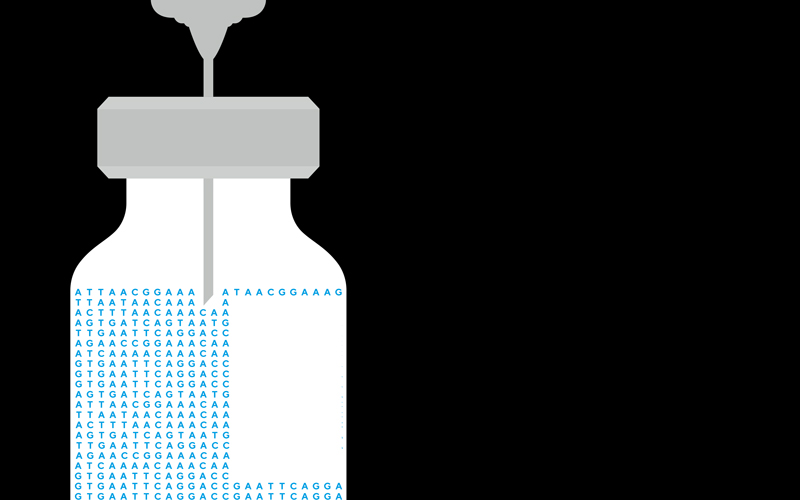A look at the international trial of the world’s first personalised mRNA cancer immunotherapy for melanoma and its potential translation to other cancers and diseases.

At a glance
- Phase 3 trials are underway for a personalised mRNA-based vaccine – the same genetic-delivering technique used in the recent COVID vaccines – to prevent melanoma.
- The phase 2 study found there was a 49% reduction in the risk of recurrence or death after three years compared with the standard treatment.
- The strategy could work not just in fighting other cancers, but also some other diseases.
Melanoma used to have the reputation of being a difficult disease to treat. As the most aggressive of skin cancers, it is adept at evading the host immune system and spreading to other organs. Once metastasised, the chances of successful treatment were not great. But that has changed.
Figures from Cancer Research UK show that of the people diagnosed with melanoma skin cancer in England in the 1970s, just less than half (46.1%) survived the disease for more than 10 years. Fast-forward several decades and the rate of survival for 10 years or more between 2013 and 2017 was 87%. It’s a substantial improvement, especially in the context of a large increase in the incidence of melanoma since the 1990s. The rate since then has doubled among females and almost tripled among men; from 2016 to 2018, the average number of new cases of melanoma skin cancer in the UK was 16,744.

That represents a big burden of disease – it’s the fifth most common cancer in the UK. As with many other cancers, the prospect of survival has improved over the years thanks to continuous improvements in diagnostics, surgical techniques, radiotherapy and chemotherapy.
A more recent development that has had a telling impact and promises to advance treatment even further is immunotherapy.
A new immunotherapy treatment
In 2019 a combination of two immune checkpoint inhibitors – ipilimumab and nivolumab – produced significant results in patients, helping their immune systems to locate the evasive melanoma cancer cells and then kill them.
The technology has now advanced another step with the announcement from University College London Hospital (UCLH) of INTerpath-001, an international phase 3 clinical trial of a new immunotherapy treatment for people who have already had high-risk melanomas removed. The aim is to prevent the recurrence of the disease and so improve the survival rates.
The trial is centred around an mRNA-based vaccine – the same genetic-delivering technique used in the recent COVID vaccines. But in this case the treatment is a personalised vaccine. The therapy begins by taking a sample of the patient’s tumour and then using DNA sequencing, with the assistance of AI and some heavy-duty computational power, to determine its genetic fingerprint. From this a bespoke vaccine is made, designed to prompt the patient’s immune system to produce several different proteins to attack specific neoantigens in the cancer cells. To complete the counterpunch, the vaccine is combined with pembrolizumab, another checkpoint inhibitor, that blocks the cancer’s defences.
The phase 2 study, carried out between 2019 and 2021, and published earlier this year, showed that the risk of recurrence or death after three years compared with the standard treatment was reduced by almost half (49%). For phase 3, just over 1000 patients are being recruited from around the world, including the UK.
The national coordinating investigator of the new trial, UCLH medical oncologist Heather Shaw, summed up the idea behind the vaccine: “By prompting the body to make these proteins, it can prepare the immune system to quickly identify and attack any cancer cells bearing them, with the aim of preventing recurrence of melanoma.”
“A target you’ve used in the past may suddenly no longer be present on that tumour, and so you need to change the target”
Selective specific responses
This timely and unique stimulation of the patient’s immune system – this personalised medicine – is what makes the trial so intriguing.
Guy Orchard, a Consultant Biomedical Scientist at St John’s Specialist Laboratories at St Thomas’ Hospital, says it is an exciting development. “The technology used this time is somewhat different to the existing technologies that we have for treating malignant melanoma patients. Previous forms of immunotherapy have been produced in various forms, but the most important thing this time is the raising of a selective specific response that is unique to a particular patient and this particular patient’s tumour. That is the novel side of what this immunotherapy is about.”
Matt Griffiths, Principal Lecturer in Cellular Pathology at Nottingham Trent University, says the trial also demonstrates the value of the mRNA vaccines. “We saw the rapid development and rollout of that in COVID, and then the ability to use that same kind of almost plug-and-play approach in other contexts.” This adaptability is vital, he says, given that cancer cells can change rapidly. “A target you’ve used in the past may suddenly no longer be present on that tumour, and so you need to change the target. Rather than starting from scratch, you can hot-swap the components in your mRNA vaccine to target the new features. Specifically with melanoma, it’s showing some fantastic results.”

“It’s like having 30-odd plus shots on goal. You get a fair chance you’re going to score and the tumour doesn’t quite know what’s hit it”
A big departure
But the vaccine has had to work particularly hard to combat melanoma, which is better at dodging immune responses than many other cancers and so has the ability to metastasise relatively quickly.
“This is why it’s not just the vaccine on its own, it’s in conjunction with a well-established immune therapy drug,” says Guy Orchard. “When they’re combined in this way, the trials to date have shown a significant increase in the disease-free survival rates. So the strategy is to analyse a tumour, identify 30-odd proteins unique to that tumour in that patient, then create the mRNA. That’s the building block and very specific set of instructions telling the body to take on those target proteins. In a nutshell, it’s like having 30-odd plus shots on goal. You get a fair chance you’re going to score and the tumour doesn’t quite know what’s hit it.”
In this sense, the new vaccine is a big departure from previous approaches to halt melanoma and its spread, says Matt Griffiths. “Looking at an individual’s biology to target their specific tumour is very distinct from saying, ‘let’s try this drug first, then the second one and the third one, and see how we get on’. Determining what specific treatment is going to be most effective for that patient is fantastic not only in terms of their outcomes, but also in terms of the cost effectiveness. It’s wins all round.”
However, it should not be forgotten that the treatment is personalised.
“It works on the premise that you are raising a specific response against a selective patient’s tumour,” says Guy Orchard. “If you put it into another patient with a similar tumour, with similar parameters, it won’t work. But this is a good glimpse into how strategies are being developed to fight cancer and this will work not just with melanoma.”
Fighting cancer: personalised approaches
Neoantigen vaccines: the mutated proteins found in cancer cells are ideal targets for personalised vaccines, such as the mRNA-based vaccine under test in INTerpath-001.
Dendritic cell vaccines: these immune cells are loaded with tumour antigens ex vivo and then put back into the patient to stimulate the appropriate immune response.
Tumour lysate vaccines: also known as whole-cell vaccines, the patient’s whole tumour cells are adapted to make it easier for the immune system to locate them.
Peptide vaccines: short protein fragments – peptides – can be tailor-made in the laboratory to mimic the unique mutations in the patient’s cancer cells, giving the immune system a target.
CAR T-cell therapy: the patient’s T-cells are adapted to carry the chimeric antigen receptor (CAR). The resulting CAR T-cells are infused back into the patient where they attack the cancer cells.
Other cancers
The mRNA strategy is being trialled elsewhere. Back in 2020, phase 1 research carried out at The Royal Marsden NHS Foundation Trust in Surrey developed personalised vaccines and gave them in combination with atezolizumab, another immune checkpoint inhibitor, to 144 patients with advanced cancers, including lung, breast, colorectal and melanoma. Many patients showed the appropriate immune reaction, but the clinical response was low, possibly because of the advanced disease and range of treatments already deployed.
The same vaccine has since been tested at the Memorial Sloan Kettering Cancer Center in New York. Researchers there reported at this year’s American Association for Cancer Research (AACR) Annual Meeting that phase 1 trials for patients with pancreatic cancer had resulted in vaccine-activated immune cells persisting in certain patients for up to three years.
At the same meeting, researchers from the Institut Curie in Paris said that a newly developed vaccine that delivers personalised neoantigens was effective in patients with head and neck squamous cell carcinoma.
The researchers suggested it could help reduce the high risk of disease recurrence after surgery.
“It’s exciting to see that this technology can be applied to many other cancer types,” says Guy Orchard. “It looks as though it can improve disease-free survival rates and reduce the rates of recurrence. That’s great, but we now need to see what the longer-term picture is. It is amazing to think that from a global pandemic that forced immediate action we have found and applied the same approach to fight cancer, proving once again that scientific innovation and adaptability are key to how we refine and develop treatment strategies.”
Other diseases
Could this sort of personalised technology also be applied to other diseases? “It’s an intriguing thought and I’m sure it’s being looked at. However, you are looking at a different set of requirements. For instance, you have to be careful when using targeted therapies in autoimmune states. The complexity level might be more significant.”
Matt Griffiths says that the potential is there for certain conditions, such as neurodegenerative diseases. “A lot of the existing treatments either don’t really work very well or they’re not as effective as we’d like. With more focus on the biology of individual patients, we might be able to tailor a more effective response. It’s too early for anything more than vague speculation, but I think that’s an area where we’re going to see more research.”
Impact on biomedical scientists
While personalised medicine may hold great promise for the patient, what might it mean for biomedical science? For a start, research may also shift towards investigating the mutations and biomarkers of individual disease. But developing personalised vaccines and similar therapies depends on the data-heavy analysis of the genome, and other personalised health data, of each individual patient. To extract meaningful insights from this vast reservoir of data, increasingly sophisticated methods for systematic analysis will need to be introduced.
This raises questions of scalability, cost-effectiveness and infrastructure. The recent UKHSA Pathogen Genomics Strategy mentioned “leveraging” existing capacity but otherwise skimped on the detail. Any firm direction on how biomedical services will be expected to meet the demand of personalised medicine is equally uncertain.
What seems clear is that the focus of biomedical workload may need to adjust, depending on the results of the trials of personalised vaccines over the next few years, though that adjustment may not be drastic. In 2020, the International Consortium for Personalised Medicine published a vision paper looking at what the landscape of personalised medicine might look like in 2030. It concluded that “personalised medicine is not so much a paradigm change as the evolution of medicine in a biotechnology and data-rich era”. It also envisaged multidisciplinary teams of “health professionals trained in digital technologies, biomarker examination, and data analysis” and expected a “strong focus on digital literacy”.
Testing personalised vaccines: The steps

- Analyse the genome: a comprehensive scan of a patient’s tumour DNA looks for unique mutations or biomarkers.
- Tag the target: once the specific biomarkers have been identified, they will be marked as the targets for the personalised vaccine.
- Design the vaccine: it needs to instruct the immune system how to recognise the cancer cells that carry the targets and attack them. Approaches include neoantigen vaccines, peptide vaccines and dendritic cell vaccines (see the box “Fighting cancer: personalised approaches”).
- Administer the vaccine: usually given to the patient via injection or IV drip. The immune system then launches its search-and-destroy response against the cancer cells.
- Monitor the patient: the efficacy of the vaccine, and any side effects, are observed. Other treatments, e.g. immune checkpoint inhibitors, may be combined with it to optimise effectiveness.
Ethical issues
Perhaps a more immediate area of concern surrounding personalised medicine is the set of ethical, regulatory and legal issues it brings with it. This includes matters of privacy, consent, and equal access to care. Already thorny subjects in the digitised world of healthcare, the debate is only likely to intensify.
Matt Griffiths feels that the UK is better placed than some other nations in confronting these issues. “We’ve got the NHS and everybody has access, though there is of course some disparity. Generally we also have quite good data security. We’re not storing big genome data, which we might then sell on to health insurers and so on. As long as we maintain that data security and ensure we have an ethical perspective around that, and we continue with our patient confidentiality and standards, I don’t think it poses a risk.”
The prospect of personalised medicine extending into personalised risk profiling, with genome analysis from birth predicting the potential health trajectory for the whole of an individual’s life, opens a far bigger can of fatter and more slippery ethical worms.
In the meantime, we can but wait with anticipation for the results of the latest trials of personalised vaccines and what they reveal about the outcomes tailored-made therapeutics are capable of delivering for patients with melanoma and other cancers.
Explore Further
- The phase 2 study, published in The Lancet: bit.ly/3ykNCEH
- American Association for Cancer Research Annual Meeting: bit.ly/4byr2H1
- Biomedical Scientist article on the development of COVID-19 vaccines: bit.ly/4alwVGi
Image credit | iStock | Shutterstock




